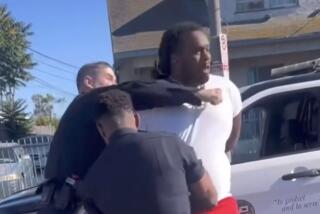Experts Approach With Caution
- Share via
Trying to resolve whether officers’ actions were justified--the question now before investigators in the case of a controversial police incident in Inglewood on Saturday--is one of the murkier areas of police discipline.
There are guidelines, but there is no precise blueprint for how police should use force. What’s required varies with the situation.
Generally, police are authorized to use force, even deadly force, in defense of themselves or others. Judging whether excessive force was used is the key to cases of alleged brutality.
A number of experts were cautious in trying to assess the Saturday episode, which was partly videotaped by a witness. Mindful of past cases like the Rodney King beating, in which key elements of the event were not caught on tape, they were quick to point out that not all the facts about the Inglewood case are known.
“When you see a portion of an incident, it is important to know total context of incident from beginning to end,” said Bob Stresak, a senior consultant with the California Commission on Peace Officers Standards and Training. “What initiated the stop? What knowledge were the officers armed with? What type of area was it--a high crime area? Was this initiated by suspect description related to a serious felony? All those components need to be taken into account” when evaluating use of force, he said.
Jim Pasco, executive director of the National Fraternal Order of Police, said there should be no rush to judgment because “a lot of things happened before that videotape started rolling.”
But many police officers were uneasy with what they, and millions of television viewers, saw on the videotape: images of police slamming a limp, handcuffed teen-ager onto a car and then punching him in the face.
In particular, striking someone who has already been handcuffed, in most cases, violates “a cardinal rule” of use of force, said Greg Berg, a retired LAPD commander who is now director of community and safety services for Cerritos. “When someone is handcuffed, everything is finished at that point.”
Inglewood police officials say 16-year-old Donovan Jackson, whom his lawyer describes as developmentally disabled, became violent before the videotape begins.
But Saturday’s incident, and the unusual videotaping, was enough to nudge some police officials out of their usual reticence to pass judgment on fellow officers.
“You only apply force when there is something the force is going to accomplish,” said LAPD Deputy Chief David C. Doan.
“It’s clearly a policy of ours: Just like we don’t shoot moving cars, we don’t hit handcuffed suspects,” said Cmdr. Jim McMurray, head of LAPD internal affairs. “You use whatever force is appropriate to get [a suspect] to stop resisting.... Then once a person stops resisting, you stop using force.”
There are exceptions, officers said. If a suspect is still violent while in handcuffs, officers are justified in continuing to use force. A number of police officials told of suspects who spit, bite or kick while handcuffed, sometimes violently enough to smash the windows of patrol cars.
But officers have tools to control a suspect without throwing punches, they said. Even if an officer had been hit by the suspect, said D.P. Van Blaricom, a use-of-force expert and former chief of the Bellevue, Wash., Police Department, he or she has no right to strike back when the suspect is handcuffed and not resisting.
“I’ve been hit, bit and spit on,” he said. “That’s part of the job. Once you have the person in custody, you don’t get to inflict summary punishment on them.”
The videotape repeatedly played on local television news stations quickly became the talk of law enforcement--especially in the LAPD, which has a history of high-profile use-of-force incidents dating back decades. Examples of suspects being beaten or harmed while handcuffed or restrained are immortalized in the Christopher Commission report, an exhaustive examination of the King beating in 1991.
LAPD training commander George Gascon said the videotape even hit a sour note with a group of new LAPD recruits who had seen the videotape, and discussed it among themselves. “They were disturbed,” he said.
Only a few years after being subjected to thorough scrutiny in the wake of the King beating, the LAPD was rattled by a second, high-profile scandal involving brutality when revelations of corruption in the agency’s Rampart Division surfaced. The department has undergone elaborate and expensive changes since then, adding new audit departments, raking in complaints and attempting to crack down on officers who conceal wrongdoing. But a fail-safe formula to prevent officer misconduct has yet to be found.
Training is not enough to prevent misconduct, LAPD Capt. Sergio Diaz said. “It takes action on a lot of different fronts. You have to set the tone, in all your communications with subordinates.... You take complaints very seriously, you let officers know they are not allowed to cover up serious misconduct.”
More to Read
Sign up for Essential California
The most important California stories and recommendations in your inbox every morning.
You may occasionally receive promotional content from the Los Angeles Times.










